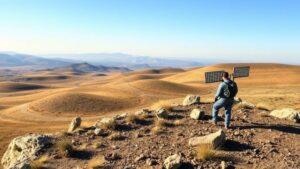Exploring Deserted Mines for Secret Vaults and Treasure Stashes
Exploring Deserted Mines for Secret Vaults and Treasure Stashes
The allure of hidden treasures and secret vaults within deserted mines captures the imagination of adventurers, historians, and treasure hunters alike. The romantic notion that valuable relics or wealth lie beneath the surface adds an intriguing layer to the study of mining history. This article delves into the intricate relationship between deserted mines and treasure through the lens of historical context, exploration methods, and potential risks associated with such endeavors.
The Historical Context of Mines and Treasure
Mining has been a fundamental aspect of human civilization for centuries. Various cultures have used the materials extracted from mines, such as gold, silver, copper, and coal, to fuel economies and craft exquisite artifacts. But, with the decline of certain mining operations, these once-bustling sites are often left abandoned, accompanied by speculation about hidden treasures.
As an example, during the California Gold Rush (1848-1855), numerous mines sprung up across the state. Many miners, lured by the promise of wealth, reportedly left behind tools, gold dust, and even personal belongings as they moved on. serialized tales of specters and ghost towns add to the mystique surrounding these deserted locations.
Identifying Potential Treasure Sites
When seeking out abandoned mines for potential treasure, several factors can inform the search. Understanding mining history and patterns can significantly enhance the probability of success. Here are some critical aspects to consider:
- Historical Research: Investigating the mines history, including its peak production years, can offer insights into the likelihood of treasure. Mines that ceased operations suddenly often hold unexplored areas.
- Geographical Factors: Observing the geographical features surrounding a mine can also yield clues. Mines located near rivers or transportation routes were often favored for deposits, increasing the chances treasures might have been stored or hidden nearby.
- Local Folklore and Legends: Many communities have local legends surrounding mines that suggest hidden stash locations. While not always reliable, such anecdotes can lead treasure hunters to unexplored areas.
Case Studies: Notable Discoveries
Throughout history, several notable discoveries of treasure have emerged from deserted mines. One such example includes the discovery of gold nuggets in the Lost Dutchman Mine in Arizona. According to folklore, this mine contains vast riches, but its exact location remains a mystery, attracting treasure hunters for decades.
Another example is the Atacama Desert in Chile, where metal ore searching has led to the uncovering of ancient Incan loot and valuable minerals. Some expeditions have found artifacts that date back centuries, providing both financial and historical rewards.
Modern Exploration Techniques
Todays treasure hunters have access to a suite of advanced technologies that can aid in locating hidden treasures within abandoned mines:
- Geophysical Surveys: Techniques such as ground penetrating radar (GPR) and electromagnetic surveys enable treasure hunters to detect anomalies beneath the surface without intrusive digging.
- Drones: Drone technology provides aerial views that can help explore accessible or dangerous areas otherwise difficult to reach, offering detailed topographical insights.
- Metal Detectors: Handheld or ground-mount metal detectors pinpoint metallic objects, enabling treasure hunters to locate once-hidden stashes.
Potential Risks and Legal Considerations
While exploring deserted mines can be exhilarating, it is essential to recognize the risks involved. Abandoned mines often present hazardous conditions including unstable structures, toxic gases, and wildlife encounters. Proper safety gear, including helmets, flashlights, and respiratory protection, is crucial for ensuring personal safety.
Also, legal considerations must be acknowledged as well. In many jurisdictions, entering private or abandoned properties without permission is illegal and can lead to trespassing charges. It is advisable to seek permission from landowners or investigate local laws before undertaking exploratory endeavors.
Actionable Takeaways
For those intrigued by the prospect of exploring deserted mines for treasure, a systematic approach is vital:
- Conduct thorough historical research to identify promising sites.
- Use modern exploration techniques and technologies to enhance discovery efforts safely.
- Be aware of legal and safety risks associated with exploring abandoned mines.
To wrap up, the exploration of deserted mines for secret vaults and treasures is steeped in rich history, notable discoveries, and modern methods. By understanding the intricacies of mining history, utilizing advanced tools, and exercising caution, treasure seekers can embark on exciting adventures in pursuit of hidden wealth.



